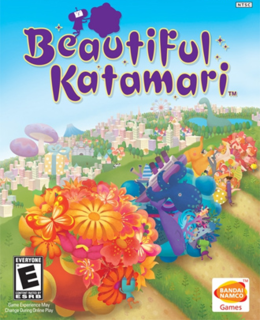The concept is still fun, but the game's rough transition to the 360 will leave fans feeling bittersweet.
Though many were excited about seeing this decidedly Japanese series transition to an American console, the process did not go smoothly. The colorful, blocky graphics were never technically astounding, but their quirky style worked with the game. Instead of upgrading the same style to a higher resolution on the more powerful console, it seems like the development team made no effort to improve the graphics. The colors are a bit washed out, and the edging of the many geometric shapes in the game is jagged. Other display problems include the King's comments during the game. They are displayed in the middle of the screen, frequently making the game difficult to play.
Graphical errors were not the only problems that cropped up as the game moved consoles. The original style of play is intact: the player rolls a ball around a landscape, collecting as many objects as possible to grow large enough to re-create destroyed planets. The beginning environments are small, and the player collects tiny objects like thumb tacks and candy. As the game progresses the player has more opportunity to grow, eventually being able to roll up giant squid or even whole continents. Though no longer as novel as it once was, the idea is still fun. Unfortunately, there are problems on the 360 that weren't apparent on the Playstation. Getting the katamari stuck between objects happens frustratingly often, an act that rarely, if ever, occurred on the first two games. The camera doesn't move as well, and it often becomes difficult to see the ball or other objects in the environment. The game also features atrociously long loading times that weren't present in the first two incarnations of the series.
Along with the technical errors, the game suffers from lack of variation. The game features 13 scant stages, fewer than either of the proceeding games. Playing a sequel that offers substantially less content that its predecessors is a huge disappointment. Many levels are available for download in the Xbox Live Marketplace, but they are pricey and should have been included in the game instead of making users pay extra for them. At its original $40 retail price, Beautiful Katamari proposed itself as a budget game, but the prices of the additional content required for the full set of levels destroys the appearance of a low price. We Love Katamari, the second game in the series, kept the levels fresh by introducing a huge variety of settings and challenges. Beautiful Katamari fails to offer any variety; most of the levels start from one of three locations, and there are only two levels in the game that challenge the player to do anything other than make the largest katamari possible. The final level in the game tries to structure the level differently, but this ends up being more irritating than fun.
This is all not to say the game isn't fun. Despite it's many glaring flaws, the core game mechanic is still enjoyable, and the game's many oddities will keep you laughing. The addition of achievements is a nice play incentive, and the developers did a good job of picking achievements that ran a variety of difficulties. Online play, another benefit of being on the 360, is quite fun. The game also allows you to roll the biggest katamari to date, which players will no doubt enjoy. The soundtrack, though it features less songs than some of the other games, is engaging and fits the game well.
In the end, this game is worth playing, and fans will enjoy it. Unfortunately, those fans will most assuredly have bittersweet feelings about it, enjoying the new levels but sadly wanting more levels and more polish. At its current $20 price point it's worth picking up, but if you can find the We Love Katamari for the same price that may be a better decision.

